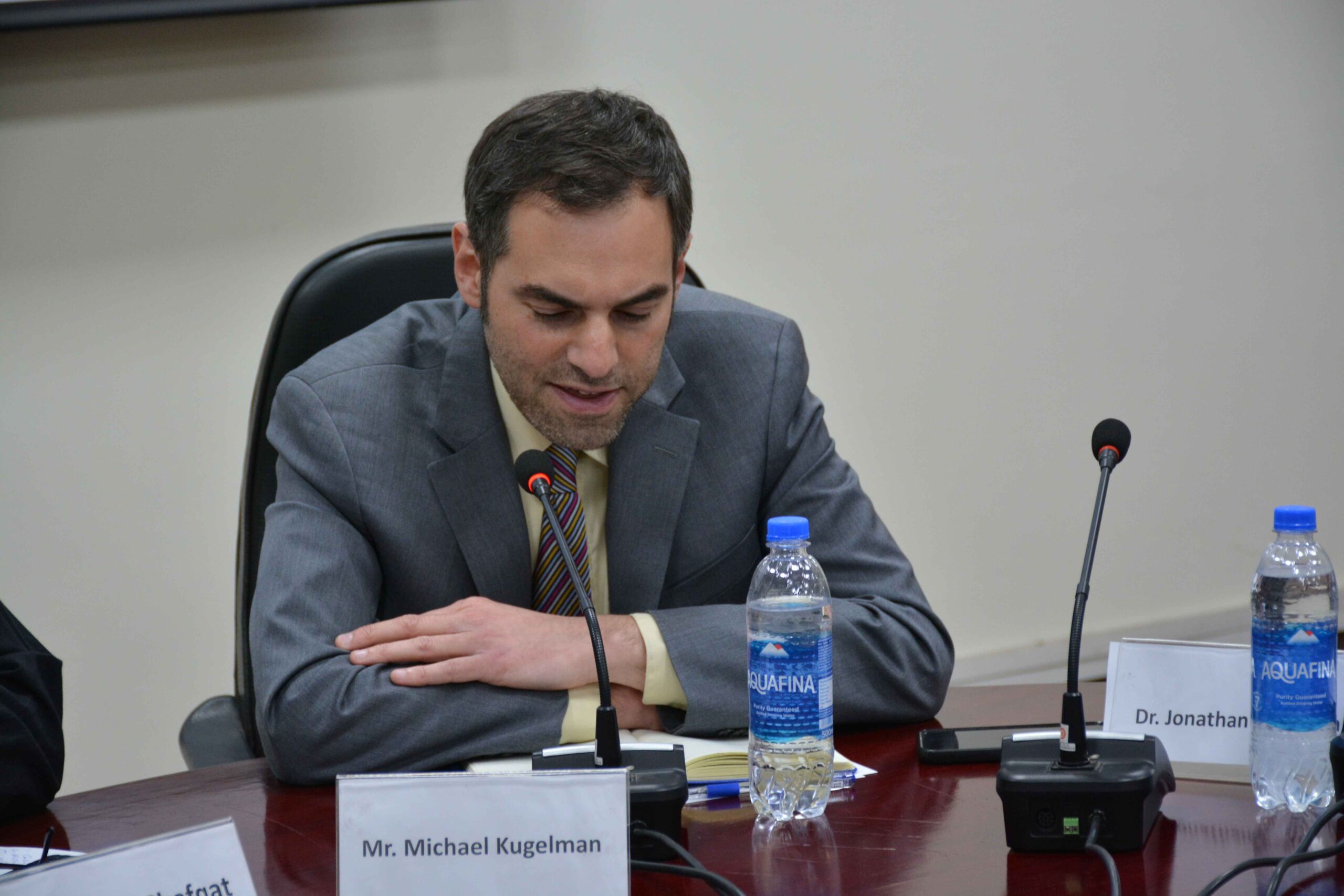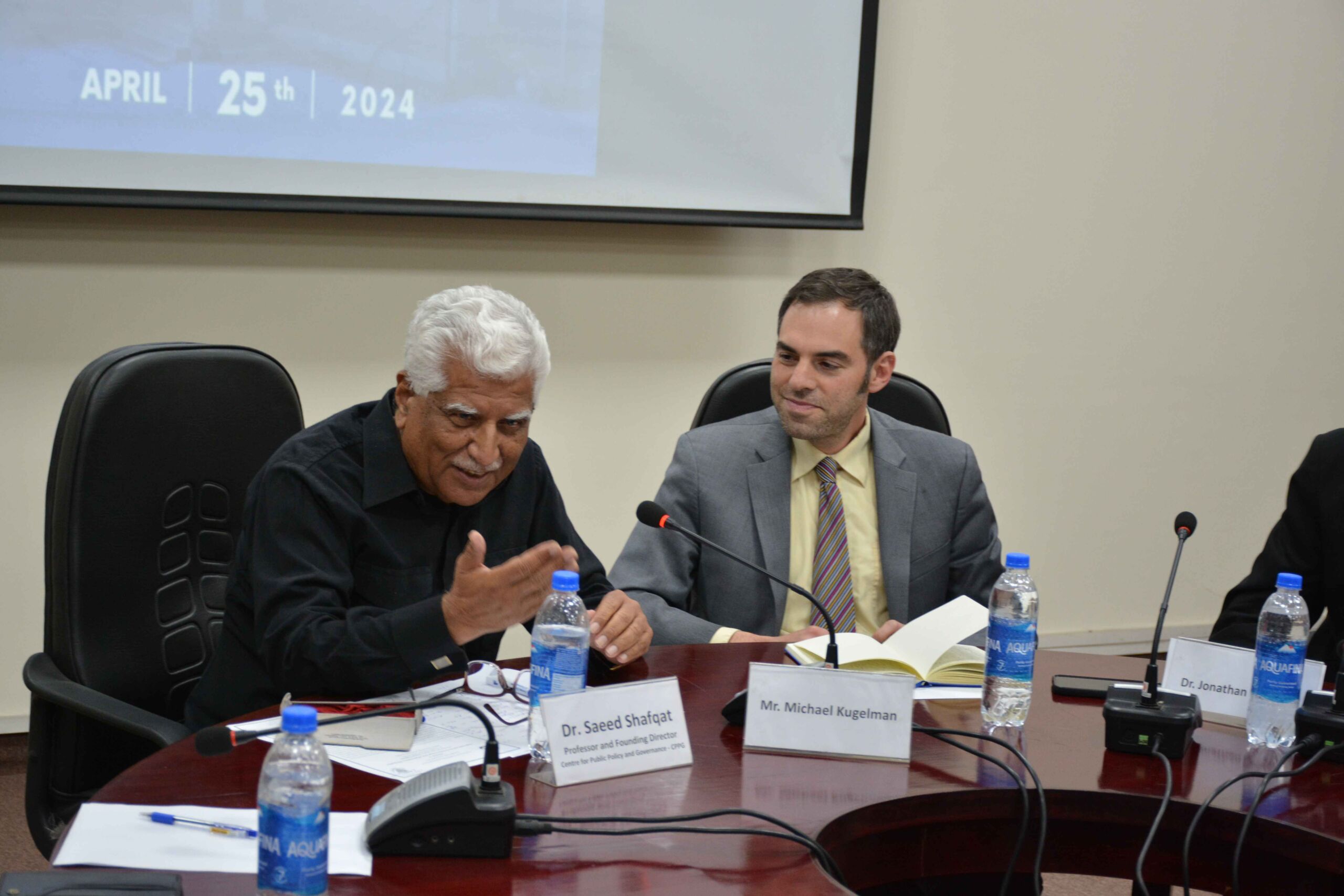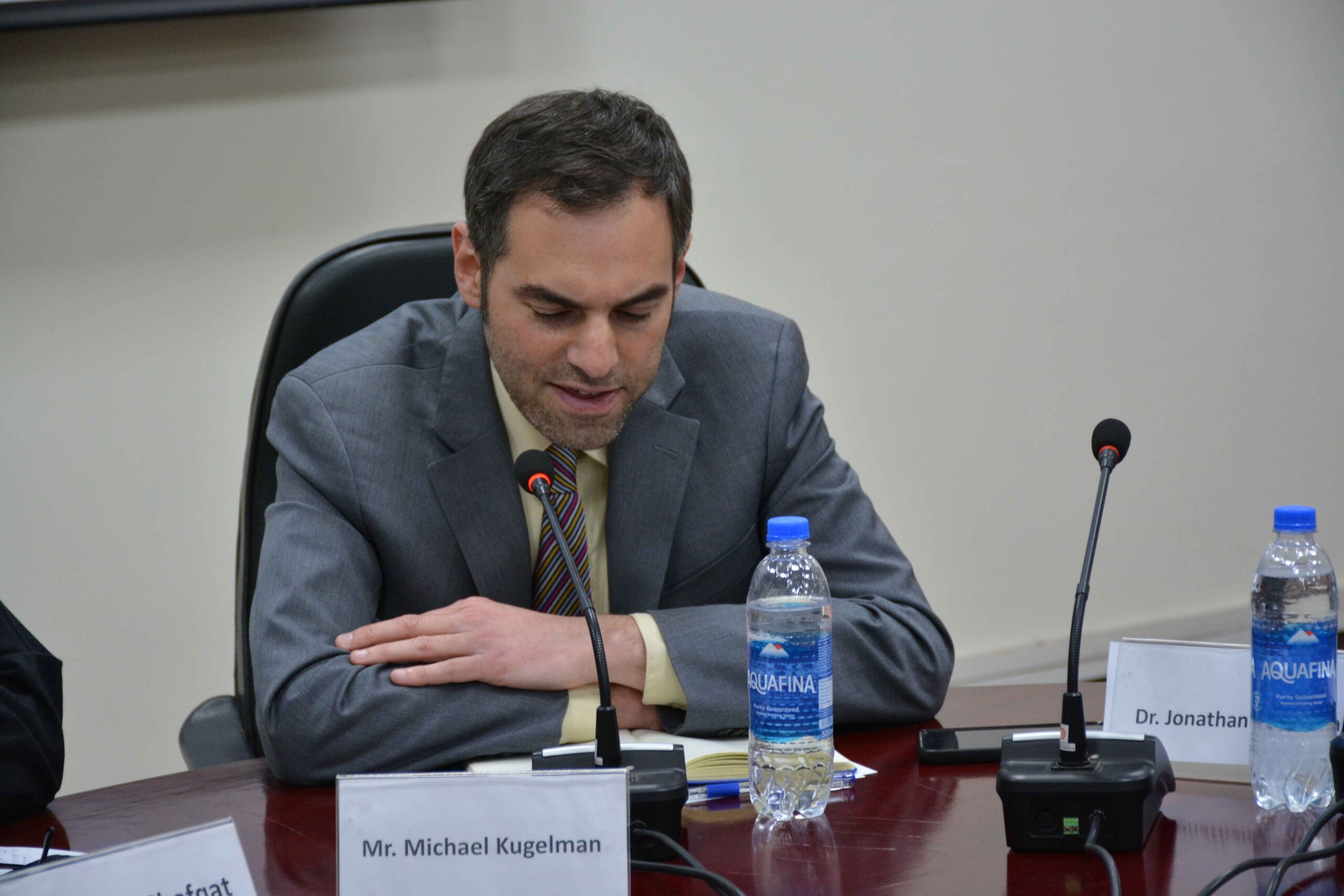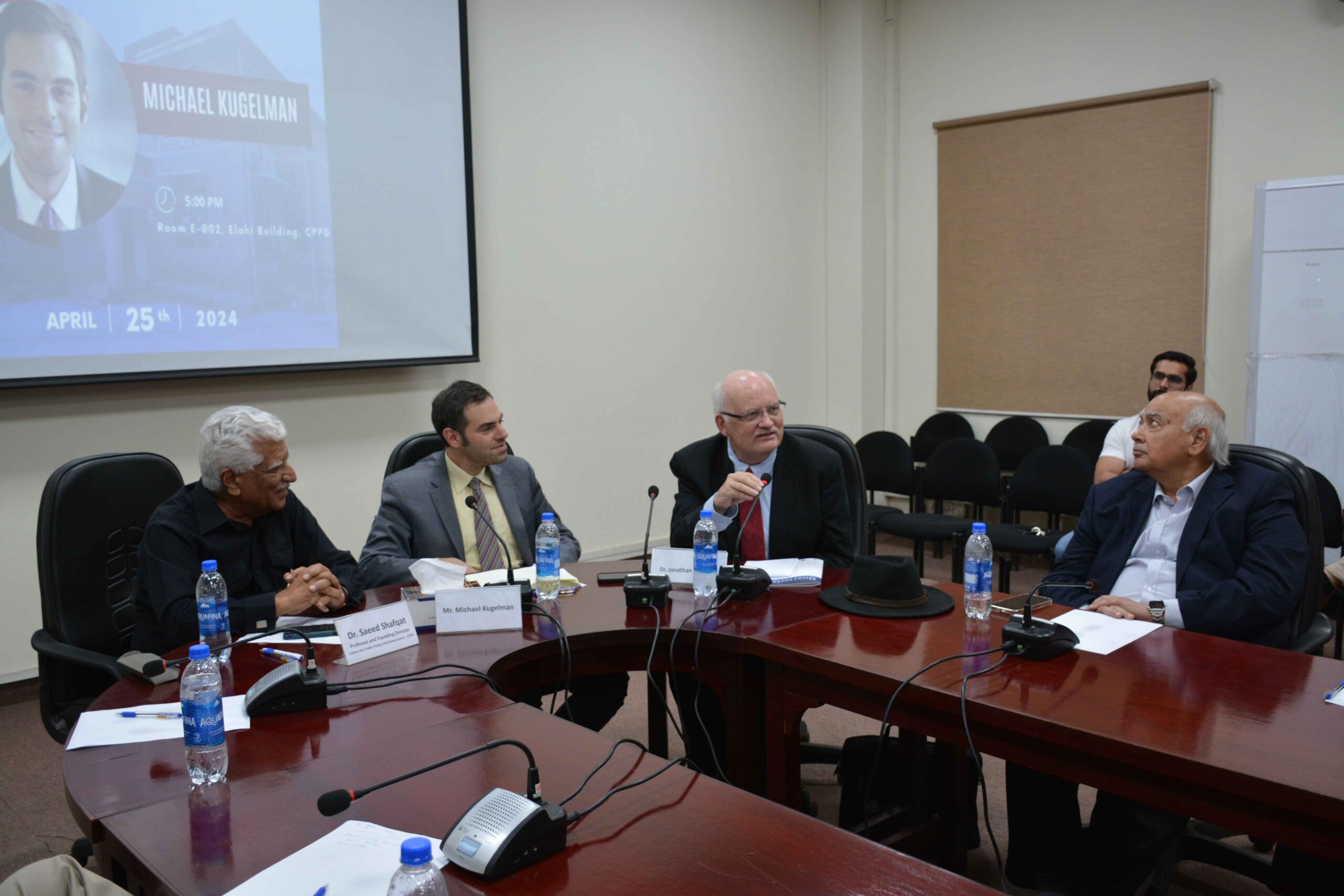
Think Tanks and the US Policy in South Asia: Misperceptions and Realities
Seminar
Past Event
Apr 25, 2024 - 5:00 pm |
Apr 25, 2024 - 7:00 pm
Michael Kugelman
E-002 CPPG FCCU
Upcoming Event
On Thursday, April 25th, 2024, CPPG organized a seminar on “Think Tanks and the US Policy in South Asia: Misperceptions and Realities”. Michael Kugelman, the Director of Wilson Center’s South Asia Institute, was invited as a guest speaker. Kugelman has managed the South Asian portfolio since 2007 and leads the Centre’s programming and research on the region. He is also a regular contributor to Foreign Policy Magazine and writes its South Asian Brief. He specializes in US relations with Pakistan, India, Nepal, and Afghanistan including Maldives.
Kugelman initiated the discussion about the geopolitical state of play in South Asia and the role of US policy in the region. He remarked that the region has been going through post-U.S.-Afghanistan withdrawal realities. Several things have changed in the geopolitics of South Asia after the Taliban took over and the U.S.’s departure from the country. For instance, we see a significant worsening of relations between Pakistan and Afghanistan. Pakistan’s relations with the Taliban have taken a different turn mainly due to the issue of TTP and the Taliban’s apparent unwillingness to act against the group in ways that Pakistan would prefer.
Interestingly, the Indian relationship with Afghanistan also does not seem as bad as many might have assumed, given the historic fundamental hostility between the Taliban and India. Astonishingly, India has partially reopened its embassy in Kabul. There have also been some engagements between Taliban leaders and Indian officials.
Additionally, the U.S. relationship with both Afghanistan and Pakistan has changed. It no longer has a formal relationship with Afghanistan as it doesn’t recognize the Taliban regime, and its relationship with Pakistan is no longer through the Afghanistan lens. Thus, the U.S.-Pakistan relationship has been in search of a new identity over the last two years. There is no major crisis between the two countries but they are struggling to redefine their relationship.
Kugelman further highlighted the prevalence of expanding and intensifying great power competition. For many years, there has been a robust India-China competition playing out across South Asia, and with time it has continued and intensified. Recently, the U.S.-China competition has intensified too, which is playing vividly in South Asia. Moreover, there is U.S.-Russia competition in South Asia as well. Speaking of the India-China relationship, Kugelman shared that since the Ladakh crisis in 2020, the relationship has plummeted, and it is still trying to recover. U.S.-China competition has reached unprecedented levels as well. Moreover, since the Russian invasion of Ukraine, the US-Russia relationship has been downright hostile.
Ever since there were allegations made by the Democratic Party that the Russians stole the 2016 elections through alleged meddling, the Biden administration, like the Democratic Party, has been very hostile to Russia. Russia’s lack of enemies in South Asia concerns the U.S. Russia even has a few friends in the region e.g. the India-Russia relationship. Russia has good relations with Bangladesh as it is a significant investor in the Bangladesh energy sector. Similarly, it has been exploring investments in hydropower initiatives in Nepal and Pakistan has recently started importing Russian oil. Kugelman remarked that this was concerning for the U.S. to try to do everything it can to make it more difficult for Russia to have partnerships and engage with other countries globally.
As for the India-China relationship, Kugelman argued China’s Belt & Road Road Initiative has been everywhere, in India too, despite the competitiveness persisting between the two countries. China and India have a robust trade relationship, entailing some degree of Chinese investments in India. He further shared that China has a significant presence throughout South Asia. China has made several infrastructural investments and this is concerning for India. The US-China competition is playing out in several ways, particularly through stepped-up US engagement with all countries in South Asia.
Moreover, in terms of the geopolitical state of play, there are seemingly hot borders in South Asia region. The China-India line of actual control situation has been especially tense since 2020. Several monthly dialogues have happened between the two militaries but there are still PLA troops hunkered down on Indian territory. As for Afghanistan-Pakistan and the Pakistan-Iran border, significant tensions persist over cross-border terrorism. Recently, serious Pakistan-Iran cross-border military strikes occurred. Meanwhile, the India-Myanmar and the Bangladesh-Myanmar borders have become tense because of the conflict inside Myanmar. Some people in Bangladesh have been killed by crossfire and spillover effects of the conflict in Myanmar. Whereas, India is concerned because of the unrest in Manipur is impacted by the Myanmar conflict. All these examples signify cross-border conflicts in the region, which are not merely restricted to the India-Pakistan frontier.
Moving forward, Kugelman talked about the sub-regionalization effect. SAARC, the main regional organization has been dead for quite some time now. But what appears to be happening is that India is leading efforts through another regional organization, the Bay of Bengal Initiative for Multi-Sectoral Technical and Economic Cooperation (BINSTEC). It aims for trade and economic cooperation between all SAARC countries, except Afghanistan and Pakistan. For example, there’s been a lot of momentum towards an electricity-sharing arrangement between India, Bangladesh, and Nepal. A new cross-border connectivity project regarding new rail lines involving India and Bhutan is also underway. Pakistan, despite its problematic relations with the Taliban in Afghanistan, is keen, perhaps as part of its geopolitics to geo-economic shift, to look into ways of strengthening ties, not only with Afghanistan, but Central Asia, to promote more cross-border connectivity. There is a new transnational rail project involving Pakistan, Afghanistan, and Uzbekistan. Kugelman argued that post-Taliban takeover, there have been more sub-regional connectivity initiatives as no country recognizes the Taliban government. So, Afghanistan today would not be welcomed in SAARC.
Shifting to U.S. policy in South Asia, Kugelman argued that during the most recent 2001 to 2021 U.S.-led war in Afghanistan, U.S. policy in South Asia had a siloed approach. U.S. pursued its policy through three narrowly defined lenses. One was fighting its war in Afghanistan. The other was working to strengthen relations with India which became prevalent during the latter years of the Afghan War, as the strategic partnership took off. Finally, it strived for a working relationship with Pakistan, linked to U.S. efforts and fortunes in Afghanistan. Other than these three, the U.S. did not have a region-wide South Asian policy. It did not give a broader geographic significance to the region except to specific countries like India, Pakistan, and Afghanistan. After the end of the Afghan War, the U.S. began to apply a new holistic lens to the region. It involved a deepening competition with China. The goal is to make South Asian countries not feel compelled to wholly rely on China for commercial and economic support. For example, the Trump administration decided to open an embassy in Male, the capital of Maldives reflecting increased U.S. attention to the Maldives and the need to strengthen engagement in pushing against China’s influence.
But China, because of B.R.I., is seemingly everywhere in South Asia, and so, the U.S. has been wholly unsuccessful in countering China and B.R.I. Initially, the U.S. was fully behind B.R.I. and CPEC, when David Hale, former U.S. ambassador, gave several interviews to local media saying that the U.S. supports CPEC and would love to be a part of it at some point. It was only when U.S.-China competition heated up that the U.S. took a principal position against CPEC and B.R.I. Alice Wells, a senior U.S. official in the Trump administration, made a speech at the Wilson Center, which was the first time a U.S. official publicly opposed B.R.I. It carried on from there. The U.S. has sought to deploy several tools to counter Chinese influence in South Asia. The main tool is the U.S. Development Finance Corporation (DFC), a new U.S. government agency that sponsors infrastructure projects focusing on clean energy, and climate change mitigation-related issues. DFC has been very active as it has already signed several projects in India and with other countries. Moreover, India, Israel, UAE, and U.S. (I2U2) is also a new quad. India-Middle East-Europe Corridor (IMEC) is another aspirational, connectivity project to came out of the recent G7 meetings.
Despite this, it is still risky diplomacy for the U.S. to see an entire region through a great power competition lens. It means that the U.S. is not pursuing bilateral relationships on their own terms but rather pursuing them through the lens of another country. It has been seen in history that the U.S. pursues ties with one country in the region through the lens of a third, and vice versa. U.S.-Pakistan is a great case study where it pursued its ties with the country to help with its goals in Afghanistan. For instance, when President Nixon decided to normalize ties with China, he saw Pakistan as a useful mediator. Thus, the U.S. strengthened its relations with Pakistan. It sided with Pakistan in the 1971 war, which had huge broader, longer-term consequences for U.S. relations with South Asia on the whole, particularly India and Bangladesh. However, Pakistan too, particularly in the early decades, pursued ties with the U.S. in part to better position itself in countering India. It had a presence in security alliances during the Cold War, or SEATO and CENTO, because it was a way to strengthen its position vis-à-vis India. But in any way, Kugelman argued that seeing relations with an entire region through the sole lens of great power competition poses risks in aggravating bilateral ties.
Lastly, coming to the role of think tanks and misperceptions about them, Kugelman presented three misperceptions prevalent in the region. Thinks tanks are considered monolithic seeking to spread one idea in the world whereas, according to Kugelman, they possess liberal, conservative, or centrist biases. There are individuals working in think tanks who develop individual policy recommendations, to share with the policy community. Additionally, it is generally considered that think tanks are a part of U.S. government, which is not true. They may have grants chartered by the Congress but they are not run by the U.S. government. Moreover, perceiving think tanks as nefarious and all-powerful is a misperception. Think tanks work to the best of their abilities to shape policymaking. However, tangible acceptance and implementation of their recommendations is not assured, as it is the domain of policymakers. The session was followed by a stimulating Q/A session.





